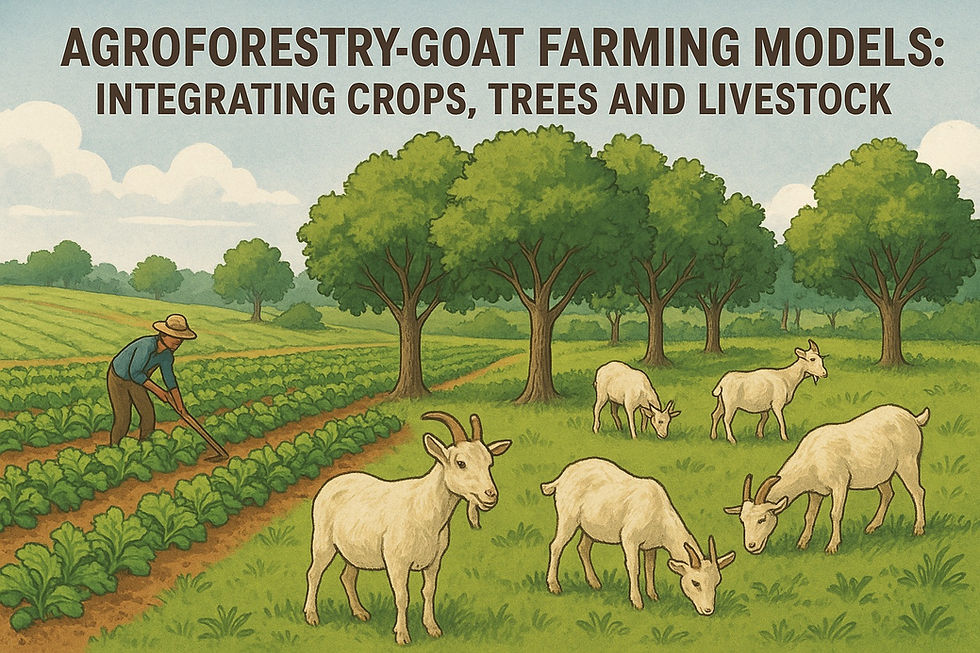Harnessing Medicinal Plants for Small Livestock Health in Tribal Areas
- Global Services TGT
- May 30
- 3 min read
Updated: Jun 10
In many tribal communities of Northeast India and Uttarakhand, small livestock such as goats, pigs, poultry, and rabbits play a crucial role in sustainable livelihood. However, limited access to modern veterinary services often poses challenges in maintaining animal health. Harnessing locally available medicinal plants offers an affordable, sustainable, and effective alternative to conventional medicine. Traditional knowledge, passed down through generations, provides insights into the therapeutic uses of various herbs and plants for livestock health.
Importance of Medicinal Plants in Livestock Care: Medicinal plants have been used for centuries in tribal areas to treat common livestock ailments, including digestive disorders, respiratory infections, wounds, and parasitic infestations. The advantages of using medicinal plants include:
Cost-effectiveness: Easily accessible and affordable for marginal farmers.
Eco-friendly: Reduces dependency on synthetic drugs, minimizing environmental impact.
Lesser side effects: Generally safer compared to synthetic antibiotics.
Preservation of Indigenous Knowledge: Promotes the conservation and utilization of traditional healing practices.
Common Medicinal Plants for Livestock Health
1. Neem (Azadirachta indica)
Uses: Antibacterial, antifungal and antiparasitic.
Application: Neem leaves can be crushed and added to drinking water to control internal parasites. A paste made from leaves can be applied to wounds for faster healing.
2. Turmeric (Curcuma longa)
Uses: Anti-inflammatory and antimicrobial.
Application: Turmeric powder mixed with warm water or honey can be fed to livestock to treat infections and improve immunity.
3. Holy Basil (Ocimum sanctum)
Uses: Respiratory relief and immunity booster.
Application: Basil leaves can be boiled and given to livestock suffering from colds and respiratory infections.
4. Garlic (Allium sativum)
Uses: Natural dewormer and immune booster.
Application: Crushed garlic can be mixed with fodder to prevent parasitic infections.
5. Aloe Vera (Aloe barbadensis miller)
Uses: Wound healing and digestive aid.
Application: Aloe vera gel can be applied to cuts, burns, and skin infections. Aloe juice aids digestion when fed in small amounts.
Methods of Preparation and Administration
Decoctions: Boiling plant parts like leaves, roots, or bark in water to extract medicinal properties.
Poultices: Crushed leaves applied directly to wounds or infected areas.
Infusions: Soaking plant materials in warm water and administering as oral treatments.
Powdered Form: Dried plant parts ground into powder and mixed with animal feed.
Challenges and Solutions: Despite the benefits of medicinal plants, certain challenges persist, including:
Lack of scientific validation: More research is needed to standardize dosages and effectiveness. Formulation is one of the areas where validation is needed for effectiveness
Limited awareness: Farmers need training on identifying, preparing, and using medicinal plants correctly, and optional herbs in case of nonexistence in the respective region/ zone
Overexploitation of resources: Sustainable harvesting methods should be practiced to prevent the depletion of plant species.
Integrating medicinal plants into livestock healthcare can significantly benefit tribal communities by reducing veterinary costs and promoting natural treatment methods. Governments, NGOs, and researchers should work together to document, validate, and disseminate knowledge on herbal livestock medicine, ensuring that these age-old remedies continue to support rural animal husbandry in a sustainable way.
Recommendations
Conduct training programs on herbal veterinary practices for tribal farmers.
Establish community herbal gardens for easy access to medicinal plants.
Promote research and documentation of traditional livestock medicine.
Conduct transacts walk to the forest and herbal gardens for the identification of the herbal plants
By embracing nature's pharmacy, tribal farmers can enhance livestock health while preserving their rich heritage of traditional home-based herbal healing practices. In India, we have some pockets where the richness of herbal plants can be seen, like Uttarakhand, Himachal, and a few other states.



Comments